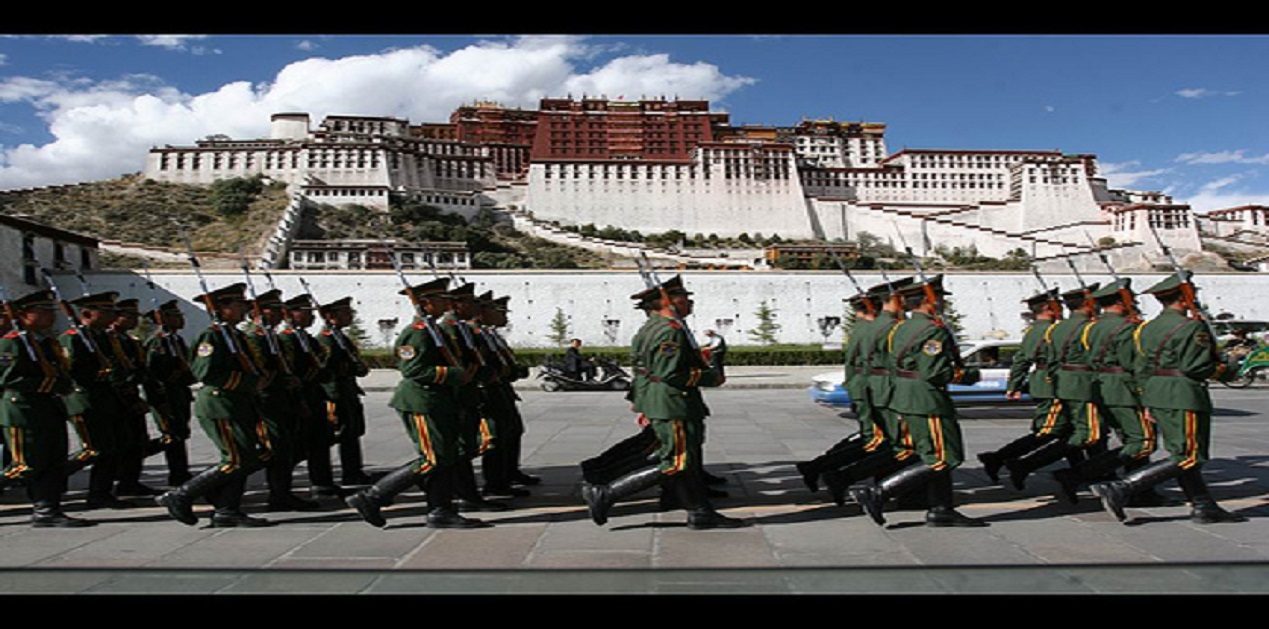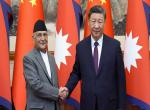Monitoring developments in the Tibet Autonomous Region (TAR) has become even more important after India's 4057-kms Line of Actual Control (LAC) with China became active along its entire length since at least May 2020, when the clash at Galwan Valley resulted in the deaths of Indian soldiers. Activities of the TAR authorities increase noticeably as they sensitise their population while preparing for any initiative or periods of tension, whether military or otherwise. Over at least the past month the higher TAR authorities have been noticed paying unusually increased attention to the border prefectures and counties.
On April 2, 2023, China’s Ministry of Civil Affairs announced a “Standardised” list of 11 geographical names of places within the Indian state of Arunachal Pradesh while referring to it as “Southern Tibet”. These were published in Chinese, Tibetan and Pinyin. This set off a wave of nationalism on China’s social media with Chinese netizens applauding the announcement and calling on China to ‘retake’ the 90,000 square kilometres of “Chinese territory” comprising almost the entire territory of India’s Arunachal Pradesh sooner or later. China claims this territory has been under India’s illegal occupation for 70 years. Predictably the posts mentioned Tawang’s religious and cultural significance as the birthplace of the Sixth Dalai Lama and claimed that the culture and religious beliefs of the people in Tawang and Tibet were very similar. Another post blamed Britain’s colonisation of India as the root cause of the current India-China dispute over Arunachal Pradesh. China had made similar announcements in 2017 and 2021 when it renamed six and 15 places respectively in Arunachal Pradesh.
A day after the so-called “standardisation” of names in “Southern Tibet” by China’s Ministry of Civil Affairs, the TAR People’s Government announced that Milin County of Nyingtri (Ch: Linzhi) and Tsona (Ch: Cuona) County of Lhoka (Ch: Shannan) would be upgraded to the City-level. Elevating these two critical border counties to the level of Cities is strategic as it places them under the direct administrative control of the TAR government at Lhasa. The population of both these places is under 27,000 and does not normally justify this administrative upgrade.
Tsona County is located just 34 km north of Bum La Pass, close to the Line of Actual Control between India and China and adjacent to Bhutan. After its upgradation to City level, Tsona’s Administrative Government was moved to Marmang Ethnic Town in Lekpo Gorge (Ch: Lebuguo). This was the site from where People’s Liberation Army (PLA) Commander Lieutenant General Zhang Guohau launched attacks against India during the Sino-Indian War 1962.
Marmang Ethnic Town, the new Administrative unit of Tsona City, is 2,800 meters above sea level and almost 1500 meters lower than the previous Tsona County Headquarters at 4300 meters. Observers assess that shifting the headquarters has socio-economic and political advantages as the relatively warmer environment would attract people to relocate and be conducive to large-scale infrastructure development. Chinese netizens have said that shifting the headquarters of Tsona to the new location at Marmang Ethnic Town, close to the LAC, shows China’s determination to “not give up an inch of land” and its will to strengthen, control and manage the eastern sector of the Sino-Indian border.
The seat of government of Milin City remains unchanged and is still in the original Milin Town.
With their elevation to the level of a City, the TAR government will exercise direct administrative jurisdiction over Milin and Tsona. This will accelerate the expeditious building of logistics infrastructure and other facilities including for the ‘xiaokang’ (model border defence well-off villages) and facilitate the mobilisation of troops and conduct of routine border patrols.
Senior TAR officials have also been noticed visiting TAR border counties since early this month. TAR Party Secretary Wang Junzheng, accompanied by four other officials from TAR inspected (Lhodrak, Tsome, Tsona, Lhuntse, Nakartse, Nedong) and other counties of Lhoka from May 4-9. The officials were: Wang Haizhou, Member of the Standing Committee of the TAR Party Committee and Director of the Propaganda Department; Dawa Tsering, Vice Chairman of TAR People’s Government; Xu Chengcang, Deputy Director of the Standing Committee of TAR People's Congress and Secretary of the Lhoka Municipal Party Committee; and Lang Fukuan, Vice Chairman of TAR People’s Government and Director of the National Language Work Committee of TAR. In addition to meeting the local people, farmers and grass-root Party cadres, the TAR Party Secretary particularly urged local officials to promote and implement the ‘Three-in-One’ management system, i.e., grassroots party building, grid-style social management and digital governance, to achieve long-term stability. He, accompanied by his team, went to the frontlines of border defence and interacted extensively with border officers, soldiers, police and border residents. He spoke of strengthening border defence and infrastructure and making border residents prosperous.
The TAR Party Secretary’s visit to Lhoka was followed by a nine-day (May 4-13) inspection tourby Zhuan Yuan, Executive Deputy Secretary of the TAR Party Committee and Secretary of the Party Group of the TAR People’s Political Consultative Conference (PPCC). He inspected the border counties of Lhoka. In addition to meeting Monastic Management Cadres and inspecting monasteries to resolve potential and “hidden dangers to stability”, Zhuan Yuan met the River Chief of Yarlung Tsangpo (Brahmaputra) to oversee the protection, management and government of the river and implementation of the work designated by the TAR Party Committee.
Almost coinciding with Zhuan Yuan’s inspections in Shigatse and Lhoka, the Head of the TAR United Front Work Department (UFWD), Karma Tsetan, inspected Nyingtri for three days from May 4-7, 2023. He inspected Lunang Town in Drayibchu (Ch: Bayi), Lamaling Monastery, Meche Temple, Karla Village (Ch: Gala), the newly upgraded MinlingCity, Minling Airport, Qionglin New Village, Lhoba Ethnic Town and Kongpo Gyamda County. Incidentally, a new airport has recently been built at Karla Village (Ch: Gala). Karma Tsetan also went to the ‘Little Red Pastoral House’ and Patriotic Re-education base in Qionglin village in Minling City, which the Party considers significant for military, national unity and border protection measures. All these places are located close to the LAC.
Chen Yongqi, Deputy Secretary and Executive Vice Chairman of TAR People’s Government, also inspected the border counties of Lhoka and Shigatse in the second week of May. He visited Lhuntse, Nakartse, Samdrubtse, Gampa and Khangmar. He emphasised the importance of maintaining a “solid” border, the need to give equal attention to the troops stationed there and welfare of people residing on the borders, improving the livelihood and social security of border residents and improving the infrastructure. He also spoke of developing traditional industries conducive to the local environment, the need to actively integrate the ‘One Belt, One Road’, and construct a South Asian Grand Corridor. Chen Yongqi stressed that maintaining a “strong border is a political responsibility and, therefore, must be fulfilled.”
From May9-12, 2023, the Chairman of the TAR People’s Government, Yan Jinhai conducted parallel inspections in Drayib-chu, Minling, Metok and Pome counties of Nyingtri. He checked the progress in construction of border defence villages, traditional industries, rural tourism and grassroots social governance. He also met frontline party cadres.
Additionally, there are reports of infrastructure construction and military activity along the LAC. On April 6, the Tashigang/Demchok Border Police Station of the Ngari (Ch: Ali) Border Management Detachment organised a patrolling exercise for police and border guards to go to the first border village, i.e. Demchok village’s Guge Duty Patrol Point. Guo Yuanjing, an official at the Tibet Frontier Inspection Station, emphasised the importance of patrolling and said that patrolling helped the border guard police keep abreast of the situation on the front line of the border to ensure its safety and stability.
Reports on March 24 revealed that China's Strategic Support Force (PLASSF) had recently established a new electronic warfare base in Nyingtri, 30km from Arunachal Pradesh (India). A photograph of the base was available on a Twitter site on March 24.
Earlier in December 2022, satellite imagery showed that China is constructing a new radome facility at Pangong Tso near the disputed China-India border. Reports suggest it is now ready. In case it is a PLA SSF facility it would be used for SIGINT collection, satellite communications, or radar. 5 kms east of the PLA's Sirijap Fort post, there is a larger size Radome at a higher altitude.
Another report on April 24 stated that the PLA has increased patrolling activities in the Metok region (opposite Upper Siang District, Arunachal Pradesh). Among the possible reasons could be: (i) Mining activities (for Rare Earth Elements); (ii) Proposed construction of 60 GW Metok HPP (Hydropower Plant); and (iii) Chinese claims along the Eastern Sector of the India-China border. A possible explanation was provided in a post (May 10) on the Chinese portal Weixin, which highlighted the importance of the Metok Hydropower Station. It said in addition to contributing to the creation of arable land in the water-starved Taklamakan Desert, the Metok hydropower station can generate up to 300 billion KWh per year, which is equivalent to saving 120 million tons of standard coal or 60 million tons of oil for all human beings every year. Calling it a great contribution to environmental protection, it declared “Whoever dares to block the construction of the Metok Hydropower Station is destroying the great goal of carbon neutrality for mankind, and whoever does so is an enemy of entire Europe and the United States. India is so well-behaved; presumably, it is definitely unwilling to do such a thing as a public enemy of mankind, right?” Metok, which is just across the border opposite Arunachal Pradesh, is the scene of considerable construction activity related to the Dam – claimed by China as the world’s largest -- that China is building on the Great Bend on the Brahmaputra (Yarlung Tsangpo).
Activities to support the troops posted in the high altitude region of Ladakh were also noticed during this period. The People’s Liberation Army (PLA) Western Theatre Command General Hospital at Chengdu issued a recruitment notice on May 9, 2023, stating that 'the hospital plans to recruit 107 professional and technical personnel in medical treatment, nursing, pharmacy, medical technology, engineering, and scientific research assistants’. Separately, the PLA authorities on May 10, announced bidding for the construction of oxygen supply systems in Shigatse, Nyalam and Chamdo in TAR. The project is estimated to cost around 3 billion yuan and is expected to be completed in 50 calendar days. The oxygen supply will help the troops stationed in remote areas of TAR to easily access oxygen without travelling back to Lhasa or other big cities.
In addition to these developments, a number of posts critical of India have been noticed during April-May 2023, on Chinese social media, like Weibo. One post claimed that Indian Foreign Minister Jaishankar’s insistence that Beijing make efforts to resolve the border first as a precursor for cooperation in other arenas should be interpreted as reflecting India’s ‘opinion that the Sino-Indian border issue is not as serious as the "Taiwan issue" and hence New Delhi regularly tests the patience of Beijing at the border’. It added that ‘China has already demonstrated her highest levels of "benevolence" towards India. New Delhi has already experienced the might of PLA during the 2020 Galwan Valley clashes and it appears that Modi would like to bring back the 1962 memories alive’. It said ‘with the induction of J-16 fighter aircraft and Type 99A Tank in Tibet, it has already become a norm in the border region. Chinese PLA should get ready to fight against India again’. An earlier Weibo post of October 2022 advocated building bridges in the Galwan Valley area. It said the ‘Galwan River Bridge has made us strategically active than instead of passively waiting for the enemy's provocation and launching a counterattack’.
These activities by China along the LAC need to be viewed in the backdrop of Beijing’s overall unfriendly attitude towards India and its unyielding stance at the 19 rounds of the border commanders’ conference. It has at this time again signalled its support to Pakistan and terrorism by rejecting the listing of Pakistan-based Jaish commander Abdul Rauf Azhar as a terrorist at the United Nations Security Council (UNSC). These developments suggest a heightened level of alert by the PLA along the LAC.
(The paper is the author’s individual scholastic articulation. The author certifies that the article/paper is original in content, unpublished and it has not been submitted for publication/web upload elsewhere, and that the facts and figures quoted are duly referenced, as needed, and are believed to be correct). (The paper does not necessarily represent the organisational stance... More >>
Image Source: www.tibetanreview.net/wp-content/uploads/2016/05/TIBET_CHINA_Army.jpg











Post new comment